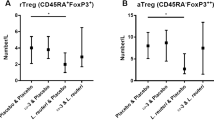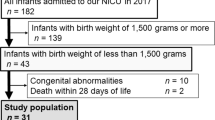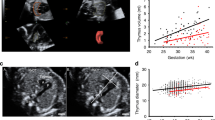Abstract
Objective:
Allergic disease is multifactorial in origin. Because iron nutrition affects immune responses and maternal pregnancy weight gain impairs fetal iron delivery while increasing fetal demands for growth, the study examined maternal pregnancy weight gain, newborn iron status and an index of atopic disease, infant eosinophilia.
Study Design:
Within a larger prospective study of healthy newborns at risk for developing iron deficiency anemia, umbilical cord iron indicators were compared to infant eosinophil counts.
Result:
Infants who developed eosinophilia exhibited higher cord reticulocyte-enriched zinc protoporphyrin/heme ratio, P<0.05 and fewer cord ferritin values in the highest (best) quartile, P<0.05. If cord ferritin was in the upper three quartiles, the negative predictive value for infant eosinophilia was 90%. High maternal pregnancy weight gain predicted infant eosinophil counts, P<0.04, and contributed to cord ferritin predicting eosinophilia, P<0.003.
Conclusion:
Poor fetal iron status may be an additional risk factor for infant eosinophilia.
This is a preview of subscription content, access via your institution
Access options
Subscribe to this journal
Receive 12 print issues and online access
$259.00 per year
only $21.58 per issue
Buy this article
- Purchase on Springer Link
- Instant access to full article PDF
Prices may be subject to local taxes which are calculated during checkout
Similar content being viewed by others
References
Kim HY, DeKruyff RH, Umetsu DT . The many paths to asthma: phenotype shaped by innate and adaptive immunity. Nat Immunol 2010; 11 (7): 577–584.
Spencer SJ, Galic MA, Pittman QJ . Neonatal programming of innate immune function. Am J Physiol Endocrinol Metab 2011; 300 (1): E11–E18.
McLimore HM, Phillips AK, Blohowiak SE, Pham DQ, Coe CL, Fischer BA et al. Impact of multiple prenatal risk factors on newborn iron status at delivery. J Pediatr Hematol Oncol 2013; 35 (6): 473–477.
Phillips AK, Roy SC, Lundberg RS, Guilbert TW, Auger AP, Blohowiak SE et al. Iron status at birth is impaired by maternal obesity and excessive gestational weight gain. J Perinatol 2014; 34 (7): 513–518.
Lowe A, Braback L, Ekeus C, Hjern A, Forsberg B . Maternal obesity during pregnancy as a risk for early-life asthma. J Allergy Clin Immunol 2011; 128 (5): 1107–1109 e1101-1102.
Halonen M, Lohman IC, Stern DA, Ellis WL, Rothers J, Wright AL . Perinatal tumor necrosis factor-alpha production, influenced by maternal pregnancy weight gain, predicts childhood asthma. Am J Respir Crit Care Med 2013; 188 (1): 35–41.
Martinez FD, Wright AL, Taussig LM, Holberg CJ, Halonen M, Morgan WJ . Asthma and wheezing in the first six years of life. The Group Health Medical Associates. N Engl J Med 1995; 332 (3): 133–138.
Castro-Rodriguez JA, Holberg CJ, Wright AL, Martinez FD . A clinical index to define risk of asthma in young children with recurrent wheezing. Am J Respir Crit Care Med 2000; 162 (4 Pt 1): 1403–1406.
Guilbert TW, Morgan WJ, Zeiger RS, Bacharier LB, Boehmer SJ, Krawiec M et al. Atopic characteristics of children with recurrent wheezing at high risk for the development of childhood asthma. J Allergy Clin Immunol 2004; 114 (6): 1282–1287.
Guilbert TW, Stern DA, Morgan WJ, Martinez FD, Wright AL . Effect of breastfeeding on lung function in childhood and modulation by maternal asthma and atopy. Am J Respir Crit Care Med 2007; 176 (9): 843–848.
Youroukova VF, Oddera S, Silvestri M, Spallarossa D, Rossi GA . Blood eosinophilia and degree of sensitization to house dust mites in preschool and school children with asthma. J Asthma 1998; 35 (6): 489–496.
Silvestri M, Oddera S, Spallarossa D, Frangova Yourukova V, Rossi GA . In childhood asthma the degree of allergen-induced T-lymphocyte proliferation is related to serum IgE levels and to blood eosinophilia. Ann Allergy Asthma Immunol 2000; 84 (4): 426–432.
Jason J, Archibald LK, Nwanyanwu OC, Bell M, Jensen RJ, Gunter E et al. The effects of iron deficiency on lymphocyte cytokine production and activation: preservation of hepatic iron but not at all cost. Clin Exp Immunol 2001; 126: 466–473.
Bowlus CL . The role of iron in T cell development and autoimmunity. Autoimmun Rev 2003; 2 (2): 73–78.
Coe CL, Lubach GR, Shirtcliff EA . Maternal stress during pregnancy predisposes for iron deficiency in infant monkeys impacting innate immunity. Pediatr Res 2007; 61: 520–524.
Mbugi EV, Meijerink M, Veenemans J, Jeurink PV, McCall M, Olomi RM et al. Effect of nutrient deficiencies on in vitro Th1 and Th2 cytokine response of peripheral blood mononuclear cells to Plasmodium falciparum infection. Malar J 2010; 9: 162.
Shaheen SO, Newson RB, Henderson AJ, Emmett PM, Sherriff A, Cooke M . Umbilical cord trace elements and minerals and risk of early childhood wheezing and eczema. Eur Respir J 2004; 24 (2): 292–297.
Blohowiak SE, Chen ME, Repyak KS, Baumann-Blackmore NL, Carlton DP, Georgieff MK et al. Reticulocyte enrichment of zinc protoporphyrin/heme discriminates impaired iron supply during early development. Pediatr Res 2008; 64: 63–67.
Just J, Belfar S, Wanin S, Pribil C, Grimfeld A, Duru G . Impact of innate and environmental factors on wheezing persistence during childhood. J Asthma 2010; 47 (4): 412–416.
Siddappa AM, Rao R, Long JD, Widness JA, Georgieff M . The assessment of newborn iron stores at birth: a review of the literature and standards for ferritin concentrations. Neonatology 2007; 92: 73–82.
Committee to Reexamine the IOM Pregnancy Weight Guidelines Weight Gain during Pregnancy: Reexamining the Guidelines. Institute of Medicine; National Research Council: Washington, D.C. 2009.
Baker RD, Greer FR . Diagnosis and prevention of iron deficiency and iron-deficiency anemia in infants and young children (0-3 years of age). Pediatrics 2010; 126 (5): 1040–1050.
Pedersen SE, Hurd SS, Lemanske RF Jr, Becker A, Zar HJ, Sly PD et al. Global strategy for the diagnosis and management of asthma in children 5 years and younger. Pediatr Pulmonol 2011; 46 (1): 1–17.
Bloom B, Cohen RA, Freeman G . Summary health statistics for U.S. Children: National Health Interview Survey, 2011. Vital Health Stat 2012; 10 (254): 1–88.
Burke W, Fesinmeyer M, Reed K, Hampson L, Carlsten C . Family history as a predictor of asthma risk. Am J Prev Med 2003; 24 (2): 160–169.
Karakoc F, Remes ST, Martinez FD, Wright AL . The association between persistent eosinophilia and asthma in childhood is independent of atopic status. Clin Exp Allergy 2002; 32 (1): 51–56.
Georgieff MK, Schmidt RL, Mills MM, Radmer WJ, Widness JA . Fetal iron and cytochrome c status after intrauterine hypoxemia and erythropoietin administration. Am J Physiol 1992; 262: R485–R491.
Gern JE, Brooks GD, Meyer P, Chang A, Shen K, Evans MD et al. Bidirectional interactions between viral respiratory illnesses and cytokine responses in the first year of life. J Allergy Clin Immunol 2006; 117 (1): 72–78.
Sumino K, Tucker J, Shahab M, Jaffee KF, Visness CM, Gern JE et al. Antiviral IFN-gamma responses of monocytes at birth predict respiratory tract illness in the first year of life. J Allergy Clin Immunol 2012; 129 (5): 1267–1273 e1261.
Nwaru BI, Hayes H, Gambling L, Craig LCA, Allan K, Prabhu N et al. An exploratory study of the associations between maternal iron status in pregnancy and childhood wheeze and atopy. Br J Nutr 2014; 112: 2018–2027.
Gentile M, Panico S, Rubba F, Mattiello A, Chiodini P, Jossa F et al. Obesity, overweight, and weight gain over adult life are main determinants of elevated hs-CRP in a cohort of Mediterranean women. Eur J Clin Nutr 2010; 64 (8): 873–878.
Saito I, Yonemasu K, Inami F . Association of body mass index, body fat, and weight gain with inflammation markers among rural residents in Japan. Circ J 2003; 67 (4): 323–329.
Lesser KB, Schoel SB, Widness JA, Kling PJ . Elevated zinc protoporphyrin/heme ratios in umbilical cord blood after diabetic pregnancies. J Perinatol 2006; 26: 671–676.
Lott DG, Zimmerman MB, Labbe RF, Kling PJ, Widness JA . Erythrocyte zinc protoporphyrin ratios are elevated with prematurity and with fetal hypoxia. Pediatrics 2005; 116: 414–422.
Acknowledgements
We thank the participating families, Meriter Hospital Birthing Center Staff, Sharon E Blohowiak, BS, MS; Daphne Q-D Pham, PhD; Anthony P Auger, PhD; Robert F Lemanske Jr, MD; and the Kling Laboratory Research Team. RW and MEB-C received fellowship support from the University of Wisconsin Medical Student Shapiro Summer Research and Cardiovascular Research Center Research Fellowships. NCD received grant support from the UW Hilldale Undergraduate Research Fellowship. PJK received grant support from NIH UL1TR000427 (UW CTSA Program), Meriter Foundation, Wisconsin Partnership Collaborative Health Sciences Program Grant and the Thrasher Research Fund. TWG and CLC have no relationships to declare for this manuscript.
Author Contributions
RW and MEB-C recruited patients, processed and analyzed samples, collected and entered data, analyzed data and contributed in writing the manuscript. NCD performed literature review, analyzed data, wrote and revised the manuscript. CLC and TWG assisted with study design, data analysis and revised the manuscript. PJK, the principal investigator for the larger study, assisted with study design, obtained funding, supervised enrollment, assays and data development and supervised in writing the manuscript.
Author information
Authors and Affiliations
Corresponding author
Ethics declarations
Competing interests
The authors declare no conflict of interest.
Rights and permissions
About this article
Cite this article
Weigert, R., Dosch, N., Bacsik-Campbell, M. et al. Maternal pregnancy weight gain and cord blood iron status are associated with eosinophilia in infancy. J Perinatol 35, 621–626 (2015). https://doi.org/10.1038/jp.2015.21
Received:
Revised:
Accepted:
Published:
Issue Date:
DOI: https://doi.org/10.1038/jp.2015.21
This article is cited by
-
Funktionellen Eisenmangel beim Allergiker mit gezielter Mikroernährung ausgleichen
Allergo Journal (2021)
-
Compensating functional iron deficiency in patients with allergies with targeted micronutrition
Allergo Journal International (2021)
-
Asthma as a disruption in iron homeostasis
BioMetals (2016)



